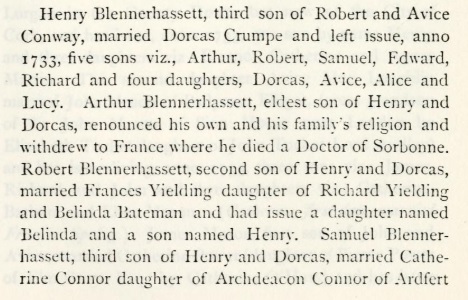Robert Blennerhassett, of Annaghgarry, Co.Kerry

Frances Yielding
listed as one of the "lives" of
[Deed of Sept 1728]
before her marriage.
Robert Blennerhassett,
born est c.1705.
Descendant of
Edward III.
See
Wikitree.
He was
of Annaghgarry, near Killorglin, Co.Kerry.
Some sources (but apparently not in his lifetime)
describe him as of "Mount Rivers"
or of
Annaghgarry House, which were meant to be two separate Blennerhassett houses, both in Annaghgarry townland.
But contemporary records just describe him as "of Annaghgarry" or "of Killorglin".
We suspect "Mount Rivers" did not exist or at least
was not used as a name for a house at Annaghgarry until a later period.
He is party to
[Deed of Nov 1728]
with his widowed mother.
About the family property at Annaghgarry.
He
mar 1728-1733 to Frances Yielding.
Robert is listed as "of Killorglin" in
[Exchequer Bill of 1736].
Robert Blennerhassett
of Annaghgarry
is party to his dau's marriage settlement
[Deed, June 1758].
Robert Blennerhassett
of Annaghgarry
is party to his dau's marriage settlement
[Deed, Feb 1762].
Robert dies, 1765:
His will
dated 17 July 1765.
"Robert Blennerhassett of Killorglin".
Wife Frances.
He died July-Sept 1765.
His will was proved
at Ardfert and Aghadoe, 16 Sept 1765,
according to [D950/1/9].
Though index says proved 1766.
Frances
is party to
[Deed of Mar 1766]
about Yielding property.
Husband must be dead.
She is NOT Frances Blennerhassett of Dublin whose will was proved 1771.
That is a different Frances.
Robert
and Frances
had issue:
- Belinda Blennerhassett.
"Black Jack's Book"
says she has been born as at 1733.
She mar pre-1765 to Charles Hurly and had issue:
- Mary Hurly,
mar Tallis Eagar and had issue.
- Henry Blennerhassett.
"Black Jack's Book"
says he has been born as at 1735.
He may be "Henry Blennerhassett" who witnessed,
along with "James Yielding" (would be his uncle),
the will of John Lombard of Co.Cork, dated 7 Aug 1761.
See abstract on page
14/51 of
[Welpy's abstracts].
- Alice Blennerhassett.
She mar 1758 to James Eagar
[born 1730] and had issue.
Marriage settlement in
[Deed, June 1758].
See entry
part 1 and
part 2
in [Eagar pedigree, 1840].
- Millicent Blennerhassett.
She mar Tallis Eagar [bapt 1 June 1729] and had issue.

Marriage settlement in
[Deed, Feb 1762].
She is written as both "Millycent"
and "Millicent" in the same document.
See
entry
in [Eagar pedigree, 1840].
- Sir Rowland Blennerhassett, 1st Baronet,


of Blennerville, Co.Kerry,
and of Churchtown, Co.Kerry.
[Debrett's Baronetage, 1815] and
[Burkes Peerage]
say born 1741.
Death notice and
[Foster's Royal Descents, vol.4, 1886]
say age 81 when died 1821, so born 1740.
"Rowland" was the name of Frances Yielding's grandfather
Major Rowland Bateman.
- Arthur Blennerhassett,


of Fortfield, Co.Kerry,
born est c.1745.
Written as "Arthur Blennerhassett Robert" (refers to his father)
in [Deeds of 1774 and 1777]
and
1790 will
and
[Deed, Nov 1821] and
[Deed, Jan 1841].
NOT written as "Arthur Robert Blennerhassett".
This is a mis-reading of his will.
- Sarah Blennerhassett.
She would be Sarah Blennerhassett of Tralee, spinster, who wit
[Deed, Oct 1770]
involving her brother Rowland.
She mar 10 Sept 1776 to John Eagar and had issue.

See
entry
in [Eagar pedigree, 1840].
Notes on multiple "DNA proven" lines
Normally, when two cousins are DNA matches, you can take it that
their lines to the common ancestor are now DNA proven.
This is more complex when the cousins are related in
multiple ways.
Many of our DNA matches below Robert Blennerhassett
and below his brother-in-law
Richard Yielding
actually have multiple lines of descent.
Which line is the DNA match proving?
We could in theory say that when there is a choice of lines,
neither line is DNA proven
since the DNA could have come through the other line.
Far more likely is that the DNA is showing up because both lines are true.
Remember these descents are proved already, from documents.
We are just talking about whether they are also proved by DNA.
We mark all of these lines as DNA proven.


Extract from
"Black Jack's Book".
Shows Robert and Frances and their two oldest children.
Younger children not born yet.
This is
pp.22-23 of MS 7937 (this section written 1735).

Transcript of the previous.
From
p.46
of [Hickson, 1872].
The will of Robert Blennerhassett was dated 17 July 1765.
The will was burnt in 1922. However notes survive, made before the fire.
See notes on
pp.8-9
of
[D950/1/9].


Notes from will of Robert Blennerhassett before it was burnt.
From
[D950/1/9, pp.8-9].
Used with permission of The Deputy Keeper of the Records, Public Record Office of Northern Ireland.
References
- Deed, 9 June 1758.
Registered 1761.
[LR] 208 334 (NOT 324) 138724.
Marriage settlement of
Alice Blennerhassett
and James Eagar.
- Deed, 10 Feb 1762.
Registered 1762.
[LR] 213 497 142388.
Marriage settlement of
Millicent Blennerhassett
and Tallis Eagar.
Our family descends from
George Cashel (born 1807),
a descendant in some way
from the Blennerhassett family of Kerry.
The question of how George descends from Blennerhassett
has been the "Holy Grail" of my family tree research.
In 2020, a combination of documents and DNA
finally proved that George Cashel
must descend from Robert Blennerhassett and Frances Yielding.
The page:
Proof of our descent from Blennerhassett
explains the findings.
Probably the natural son of one of Robert Blennerhassett's grandsons,
but for sure a descendant of Robert Blennerhassett, is:
-
George Cashel,


born 1807, Co.Kerry [according to RIC records].
We suspect he was baptised 24 July 1808.





